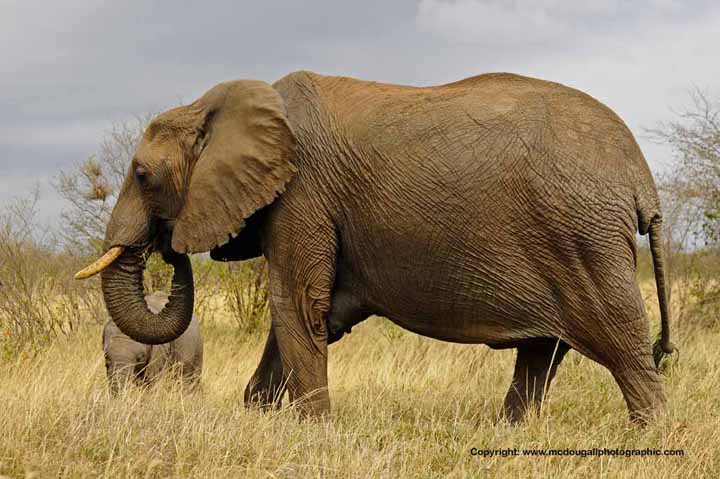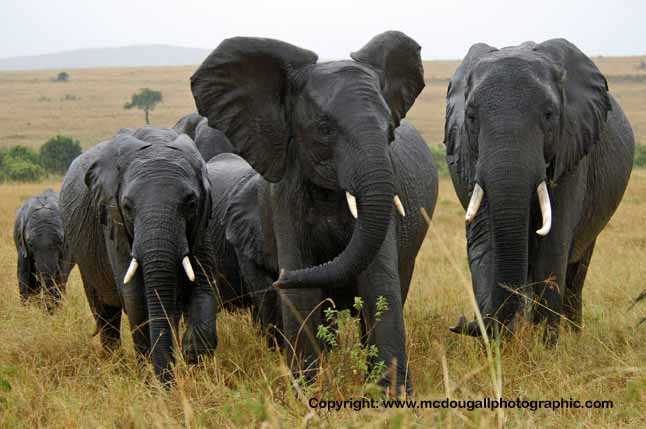Adventure
Elephant (Loxodanta Africana)
-Paul McDougall

The African Elephant is larger and has bigger ears than its Asian relative. Elephants can survive in virtually any habitat and are widespread throughout Kenya. Elephants are social animals and have a matriarchal society with herds of related females. Males
tend to be separate and are either alone or in male groups, their rank order is determined by seniority and reproductive condition. Female herds are made up of related individuals consisting of a mother and young with her grown daughters and their offspring.
Activity, direction and rate of movement are set by the matriarch, recognizable as the largest cow. Male elephants leave the maternal herd in adolescence (12-13 years) and after this never stay long with any cow herd. Elephants spend 16 hours a day feeding.
They can go several days without drinking, during which they can range up to 80 km from water, but drink and bathe daily by choice. An adult bull may drink 100 litres at a time and up to 227 litres a day. Elephants usually bathe after drinking, they roll and
wallow in shallows and may submerge completely in deep water. Elephants are very much contact animals. Family members often stand touching whilst resting or drinking. They lean and rub their bodies together, and often touch one another with their trunks. Elephants
vocal communication is limited to 4 different sounds but they vary the pitch, duration and volume which enables them to express a wide range of emotional states. After a 22 month gestation period females give birth to one calf. The Elephant was formerly widespread
south of the Sahara wherever water and trees occurred, but its range and numbers have shrunk as human population, development, and poaching have increased. Between 1970 and 1980 the population of East African elephants dropped by 80%. Elephants have more environmental
impact than any mammal but man. The beneficial effects (trails, wells, bringing food within reach of smaller browsers) are overshadowed by their destruction of trees, which has been spectacular in many African parks and reserves. In Tsavo, for example woodland
was transformed in to grassland, with the detriment to the elephants and many other species – especially black rhino. The root of the problem is the increasing confinement of elephants within parks. Tree destruction is a normal elephant activity and when spread
over a wide area contributes to habitat diversity and soil turnover. Elephants can be seen in Kenya in large numbers. They are particularly big in Amboseli where older elephants feed on the soft vegetation in the swamp areas allowing them to live longer than
the normal 60 years. Elephants in Samburu and Tsavo are generally a red colour, due to the dust that they cover themselves in. Another great place to see elephants in Kenya is in the Sheldrick Elephant Orphange in Nairobi, where baby elephants are taken in
as orphans and when they are old enough and well enough are re-introduced in to the wild of Tsavo NP.

I have again had many special moments with elephants; I have been in a vehicle with them so close you could touch them, I have been lucky enough to see large herds and even young calves. My most memorable has to relate to being charged though, it has happened
in Samburu, Tsavo East and Tsavo West – usually I manage to get in position to take a few photographs as the elephant runs at us, stops and throws its head and ears around in an act of defiance, mock charges are great. But one day in Tsavo East we were driving
on the dense thorny shrub road out of the park when we rounded a corner and encountered a huge bull elephant with one tusk. It took one look at us and charged, it soon became clear that this was not a mock charge. This bull meant business and although I managed
to take a few photographs as my good friend and business partner – Isaac reversed the vehicle at high speed down the road, I soon sat down and prayed that we would be able to keep ahead of it or it would loose interest. But it kept coming – we eventually rounded
a corner – giving us just enough time to turn the vehicle around and speed off, this bull followed us for a few km before we eventually managed to escape it. This was an old bull in musth, (characterized by highly aggressive behavior, accompanied by a large
rise in reproductive hormones – testosterone levels in an elephant in musth can be as much as 60 times greater than in the same elephant at other times). Not a good time to encounter it. We later found out after a very long diversion to the park gate that
this bull was also bad tempered as it had had a bad encounter with a safari vehicle a few months earlier. This is an unusual occurrence and not a normal safari experience, however it just reinforces that these are wild animals and you have to make sure that
you are with a qualified guide at all times.

|